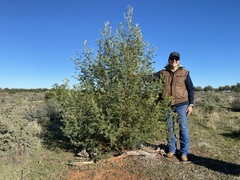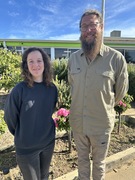From Gettysburg to Hay: The Remarkable Journey of William H. Sheppard
Contributor
08 June 2025, 5:00 AM

From Gettysburg to Hay: The Remarkable Journey of William H. Sheppard
Interred in Hay Cemetery is a gentleman named William H. Sheppard.
How did this man come to his final resting place when he was one of the fighters in the American Civil War?
Former local and author, Anthony Bennett tells the interesting tale.
BY ANTHONY BENNETT
Could a small south-western settlement have ties to a conflict 16,000 kilometres away? This is exactly how Hay, formerly Langs Crossing, connects to what some called 'The First Modern War'.
The American Civil War (1861-1865) was fought primarily over states' rights, slavery and economic differences between the industrial North and the agricultural South.
Wealthy plantation owners put profit ahead of human wellbeing.
How did Hay develop a link to this bloody conflict? The war claimed over 700,000 lives. It was fundamentally caused by racism.
The struggle continues to stir strong emotions in today's United States. How did our small community become connected to such a consequential historical event?
Hay was half a world away from the fighting. It had a modest population of just 172 citizens. The colonies of Australasia contributed approximately 140 volunteers to the conflict.
None of these volunteers came from Hay. The connection emerged after the war ended, when veterans returned home.
Not all veterans went home. This is where we find William H. Sheppard's story. He served in Company H of the 142nd Pennsylvania Infantry Regiment from 1862 to 1866, remaining in military service after the conclusion of the war.
His final resting place would be in our own Hay Cemetery. This creates our unique connection to one of history's most significant conflicts.
The 142nd Pennsylvania: A Regiment's Bloody History
The 142nd Pennsylvania Infantry was formed from counties in south-western Pennsylvania and north-western Maryland. They joined the Army of the Potomac against General Robert E. Lee's Army of Northern Virginia.
The regiment's casualty rate was staggering. Of 935 enlistees, 809 became casualties. This 86 per cent rate highlights the war's devastating human toll.
They fought in many famous engagements. These battles have become legendary in American military history.
Their first major fight was at Fredericksburg, Virginia (12-15 December 1862). This Union defeat saw thousands of Federal soldiers fall against well-fortified Confederate positions.
The 142nd next fought in the Chancellorsville Campaign (27 April-6 May 1863). This was another Confederate victory despite the South being heavily outnumbered.
Sheppard's regiment participated in the Battle of Gettysburg (1-3 July 1863). Many historians consider this the Civil War's turning point.
The Union victory at Gettysburg stopped General Lee's second northern invasion. It dealt a severe blow to Confederate morale and military prospects.
As the conflict continued, the 142nd endured the Battle of the Wilderness (5-7 May 1864). This chaotic engagement occurred in dense woodland that neutralised Union advantages.
Days later, they fought at Spotsylvania (8-12 May 1864). Some of the war's most savage fighting happened here. Soldiers engaged in hand-to-hand combat for 22 hours at the "Bloody Angle."
The regiment participated in the Siege of Petersburg, Virginia (16 June 1864-2 April 1865). This prolonged campaign prefigured the trench warfare seen later in World War I.
Finally, they took part in the Appomattox Campaign (28 March-9 April 1865). This led to the surrender of Lee's army on 9 April 1865.
A Mysterious Journey to the Antipodes
Private William H. Sheppard's post-war story remains vague. When did he come to Australia? What brought him to our shores?
These questions lack clear answers. There is little official record of his arrival or early years in the colony.
What would prompt a battle-hardened veteran to travel halfway around the world? Perhaps he sought escape from painful war memories.
Maybe Australia's gold rushes attracted him. These continued to draw fortune-seekers throughout the 1860s and 1870s.
Or possibly, like many immigrants, he wanted a fresh start. Australia was unburdened by the tensions dividing post-war America during Reconstruction.
Whatever his reasons, Sheppard made his way to Australia. He eventually settled in our town of Hay.
He lived out his remaining years as one of our community's more unusual residents. Details of his life in Hay remain sparse.
We know with certainty that he passed away on 11 October 1934. His precise age at death is unknown. If Sheppard enlisted as a young man, he could very well have been in his 90's when he died in 1934.
Considering his Civil War service, Mr Sheppard was likely in his 90s when he died. This shows impressive longevity for a survivor of history's bloodiest conflicts.
He also endured the rigours of colonial Australian life. His resilience speaks to his remarkable character.
Evidence in Our Midst
We have concrete evidence of Sheppard's presence in Hay. This comes in the form of burial records maintained by the shire.
Hay Shire Council cemetery documents confirm his resting place. William Henry Sheppard is interred in Lot 18, Row AE of the Anglican section.
This simple grave represents a tangible link between rural Australia and American history. The connection spans oceans, decades, and vastly different cultural contexts.
Not Alone: Australasian Connections to the American Civil War
Sheppard's story is unique to Hay. However, the broader Australian connection to the American Civil War deserves mention.
Despite geographic isolation, approximately 140 men and women from Australasia participated. Some were expatriates already living in America when fighting began.
Others were sailors who found themselves in American ports and enlisted. A smaller number travelled specifically to join the conflict.
They were motivated by ideological convictions, adventure-seeking, or financial compensation. These volunteers predominantly fought for the Union.
This reflected the British Empire's official neutrality but tacit Northern support. Their stories form a little-known chapter in our region's military history.
They predate our more celebrated involvements in the Boer War and World War I. Yet they represent an important international dimension to Australian identity.
The Civil War's Global Impact
The American Civil War had significant international dimensions. It disrupted global cotton supplies, affecting textile industries worldwide.
This included nascent operations in Australia. The conflict also stimulated demand for wool, benefiting Australian producers.
Our wool helped fill the gap left by the American South's diminished production. Beyond economics, the war held important political implications.
It influenced democracies and colonial societies globally. The Union victory represented a triumph for democratic governance.
It established the primacy of federal authority over states' rights. These concepts would become relevant to Australia's own federation debates decades later.
The emancipation of enslaved Americans resonated with humanitarian sentiments in Australia. Transportation of convicts had ended relatively recently in our own history.
Questions about Aboriginal treatment were increasingly entering public consciousness. These parallels created ideological connections between our nations.
Remembering Private Sheppard
Private Sheppard's journey from American battlefields to Hay reminds us how global events touch remote communities. He likely witnessed extraordinary historical moments.
Perhaps he heard Lincoln's Gettysburg Address. Maybe he saw General Lee surrender at Appomattox Court House.
He might have marched in the Grand Review of the Armies in Washington. He survived battles where thousands of his comrades fell.
He endured harsh military campaigns. He emerged to begin life half a world away from his origins.
What stories he might have told curious locals in Hay! Tales of charging across battlefields facing artillery fire.
Stories of camaraderie among soldiers. Accounts of jubilation at war's end. Did he maintain connections with Pennsylvania veterans?
Did he ever explain his journey to Australia? Did he find peace here that eluded him in post-war America?
These questions may remain unanswered. Yet Sheppard's presence enriches our understanding of Hay's place in global history.
His grave reminds us that personal journeys intersect with world events. These connections transcend borders and generations.
A Living Historical Connection
The American Civil War remains one of history's most studied conflicts. Its causes and consequences continue shaping American society today.
The war's legacy includes constitutional amendments abolishing slavery. It guaranteed equal protection under law.
It prohibited racial discrimination in voting rights. Full realisation of these principles would require another century of struggle.
For Hay, our connection to this momentous event comes through one man. Yet it represents something larger.
It shows our community's place within global movements of peoples and ideas. Sheppard's journey from Pennsylvania to New South Wales is remarkable.
It demonstrates how interconnected our world was, even in the 19th century. Our small town became part of a much larger historical narrative.
As we pass the Anglican section of Hay Cemetery, we might spare a thought for William H. Sheppard. From Civil War battlefields to peaceful retirement in rural Australia. His story, though incomplete in our records, adds unique dimension to our town's heritage. It connects us to one of modern history's pivotal conflicts.
The author would like to thank the staff of the Hay Shire Council for their assistance with cemetery records and local historical information.
NEWS
SPORT
RURAL







